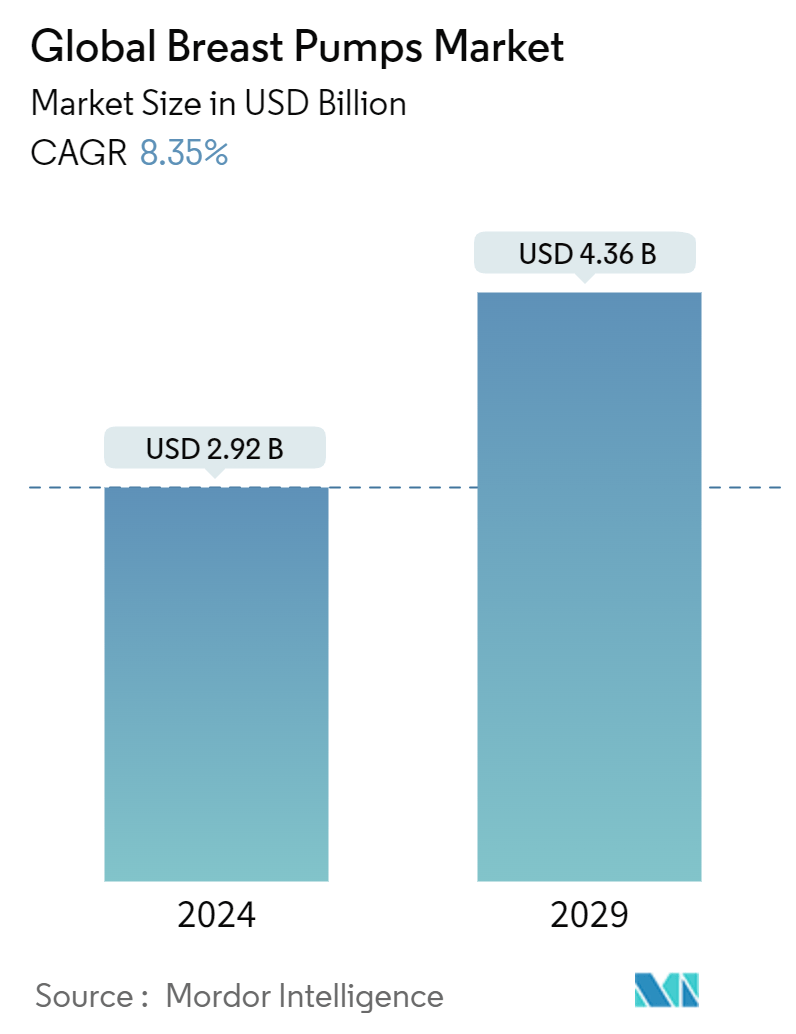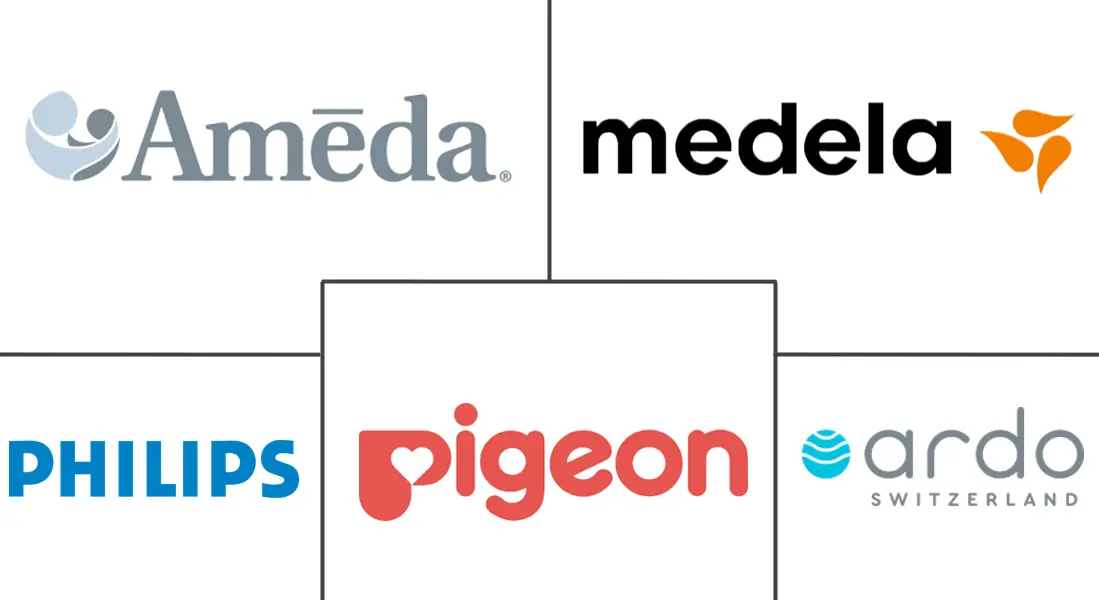Market Size of Global Breast Pumps Industry

| Study Period | 2019 - 2029 |
| Market Size (2024) | USD 2.92 Billion |
| Market Size (2029) | USD 4.36 Billion |
| CAGR (2024 - 2029) | 8.35 % |
| Fastest Growing Market | Asia Pacific |
| Largest Market | North America |
| Market Concentration | Medium |
Major Players
*Disclaimer: Major Players sorted in no particular order |
Breast Pump Market Analysis
The Global Breast Pumps Market size is estimated at USD 2.92 billion in 2024, and is expected to reach USD 4.36 billion by 2029, growing at a CAGR of 8.35% during the forecast period (2024-2029).
The major factors driving the market's growth include increasing women’s employment rates globally, improving healthcare infrastructure in emerging economies, and government initiatives supporting employed mothers.
Many working mothers rely on breast pumps to ensure their babies are fed. In contrast, at work, the demand for these devices is expected to continue growing, reflecting the evolving needs of modern families. For instance, according to the statistics from the International Labor Organization (ILO) updated in February 2022, the current global labor force participation rate for women is under 47%. Many working mothers opt for breast pumps to pump milk and feed their babies when they are away for work. As more working mothers use breast pumps to ensure their infants are fed during their absence, the market for these devices is set to grow, meeting the needs of modern working families.
Further, as more women join the workforce globally, the demand for breast pumps is rising, providing a practical solution for mothers to continue breastfeeding while managing their professional and personal commitments. As per the data updated by the WHO in December 2023, about 44% of infants (0-6 months old) are exclusively breastfed. Moreover, as per the same report, exclusive breastfeeding is recommended for the first six months of a baby’s life. Breast pumps ease the milk pumping and save a lot of time. Since the female employment rate is increasing globally, many women find it helpful to conserve breast milk after returning to work, traveling, or otherwise when separated from their infant. With the rise in female employment globally, breast pumps have become essential tools for working mothers, enabling them to pump efficiently and store milk, thereby supporting the recommended practice of exclusive breastfeeding for the first six months, which may increase the adoption of these devices among working women.
Moreover, the new product approvals and launches globally provide access to various breast pumps, driving the market growth during the forecast period. For instance, in August 2023, Lansinoh launched the new Lansinoh Wearable Breast Pump in the United States. Lansinoh's Wearable Pump empowers mothers, allowing them to pump confidently anywhere. Hence, the demand for these products is expected to surge, boosting market growth.
Therefore, the market is expected to grow during the forecast period due to the factors above, such as increasing global women’s employment rates and new product launches. However, higher prices of breast pumps are likely to limit their adoption among women, thereby restraining the market’s growth.
Breast Pump Industry Segmentation
As per the scope of the report, breast pumps are used by lactating women to extract milk from their breasts. There are many advantages to feeding the mother’s milk to infants, as breast milk contains important antibodies that help the baby develop a strong immune system, thereby decreasing the chances of being diseased. Breast pumps help boost the supply of milk and support working mothers store the milk for the infant.
The breast pumps market is segmented by product, technology, application, and geography. By product, the market is segmented into open-system breast pumps and closed-system breast pumps. By technology, the market is segmented into manual breast pumps, battery-powered breast pumps, and electric breast pumps. By application, the market is segmented into personal use and hospital grade. By geography, the market is segmented into North America, Europe, Asia-Pacific, the Middle East and Africa, and South America. The market report also covers the estimated market sizes and trends for 17 countries across major regions globally. The report offers the value (USD) for the above segments.
| By Product | |
| Open System Breast Pump | |
| Closed System Breast Pump |
| By Technology | |
| Manual Breast Pump | |
| Battery Powered Breast Pump | |
| Electric Breast Pump |
| By Application | |
| Personal Use | |
| Hospital Grade |
| Geography | ||||||||
| ||||||||
| ||||||||
| ||||||||
| ||||||||
|
Global Breast Pumps Market Size Summary
The breast pump market is poised for significant growth, driven by factors such as increasing female workforce participation, advancements in healthcare infrastructure in emerging markets, and supportive government policies for working mothers. The COVID-19 pandemic has further influenced the market, as breast pumps became essential for mothers needing to separate from their infants while still providing breast milk. The pandemic also highlighted the benefits of breast milk in providing antibodies to infants, which spurred interest in breast pump usage. Despite the higher costs associated with breast pumps potentially limiting their adoption, the convenience they offer to working mothers is expected to drive market expansion.
The market is characterized by a mix of closed and open breast pump systems, with closed systems gaining traction due to their hygienic advantages. North America is anticipated to be a key region for market growth, supported by high employment rates among women, robust healthcare infrastructure, and increased healthcare spending. Product innovations and collaborations in this region, such as the launch of new electric breast pumps, are contributing to market dynamics. The competitive landscape is moderately fragmented, with both local and international players like Medela AG and Koninklijke Philips NV actively participating. As the market evolves, new entrants are expected to introduce novel solutions, further stimulating growth.
Global Breast Pumps Market Size - Table of Contents
-
1. MARKET DYNAMICS
-
1.1 Market Overview
-
1.2 Market Drivers
-
1.2.1 Increasing Global Women Employment Rates
-
1.2.2 Improving Healthcare Infrastructure in Emerging Economies
-
1.2.3 Government Initiatives in Support of Employed Mothers
-
-
1.3 Market Restraints
-
1.3.1 High Prices of Breast Pumps
-
-
1.4 Porter's Five Forces Analysis
-
1.4.1 Threat of New Entrants
-
1.4.2 Bargaining Power of Buyers/Consumers
-
1.4.3 Bargaining Power of Suppliers
-
1.4.4 Threat of Substitute Products
-
1.4.5 Intensity of Competitive Rivalry
-
-
-
2. MARKET SEGMENTATION (Market Size by Value - USD)
-
2.1 By Product
-
2.1.1 Open System Breast Pump
-
2.1.2 Closed System Breast Pump
-
-
2.2 By Technology
-
2.2.1 Manual Breast Pump
-
2.2.2 Battery Powered Breast Pump
-
2.2.3 Electric Breast Pump
-
-
2.3 By Application
-
2.3.1 Personal Use
-
2.3.2 Hospital Grade
-
-
2.4 Geography
-
2.4.1 North America
-
2.4.1.1 United States
-
2.4.1.2 Canada
-
2.4.1.3 Mexico
-
-
2.4.2 Europe
-
2.4.2.1 Germany
-
2.4.2.2 United Kingdom
-
2.4.2.3 France
-
2.4.2.4 Italy
-
2.4.2.5 Spain
-
2.4.2.6 Rest of Europe
-
-
2.4.3 Asia-Pacific
-
2.4.3.1 China
-
2.4.3.2 Japan
-
2.4.3.3 India
-
2.4.3.4 Australia
-
2.4.3.5 South Korea
-
2.4.3.6 Rest of Asia-Pacific
-
-
2.4.4 Middle East and Africa
-
2.4.4.1 GCC
-
2.4.4.2 South Africa
-
2.4.4.3 Rest of Middle East and Africa
-
-
2.4.5 South America
-
2.4.5.1 Brazil
-
2.4.5.2 Argentina
-
2.4.5.3 Rest of South America
-
-
-
Global Breast Pumps Market Size FAQs
How big is the Global Breast Pumps Market?
The Global Breast Pumps Market size is expected to reach USD 2.92 billion in 2024 and grow at a CAGR of 8.35% to reach USD 4.36 billion by 2029.
What is the current Global Breast Pumps Market size?
In 2024, the Global Breast Pumps Market size is expected to reach USD 2.92 billion.

